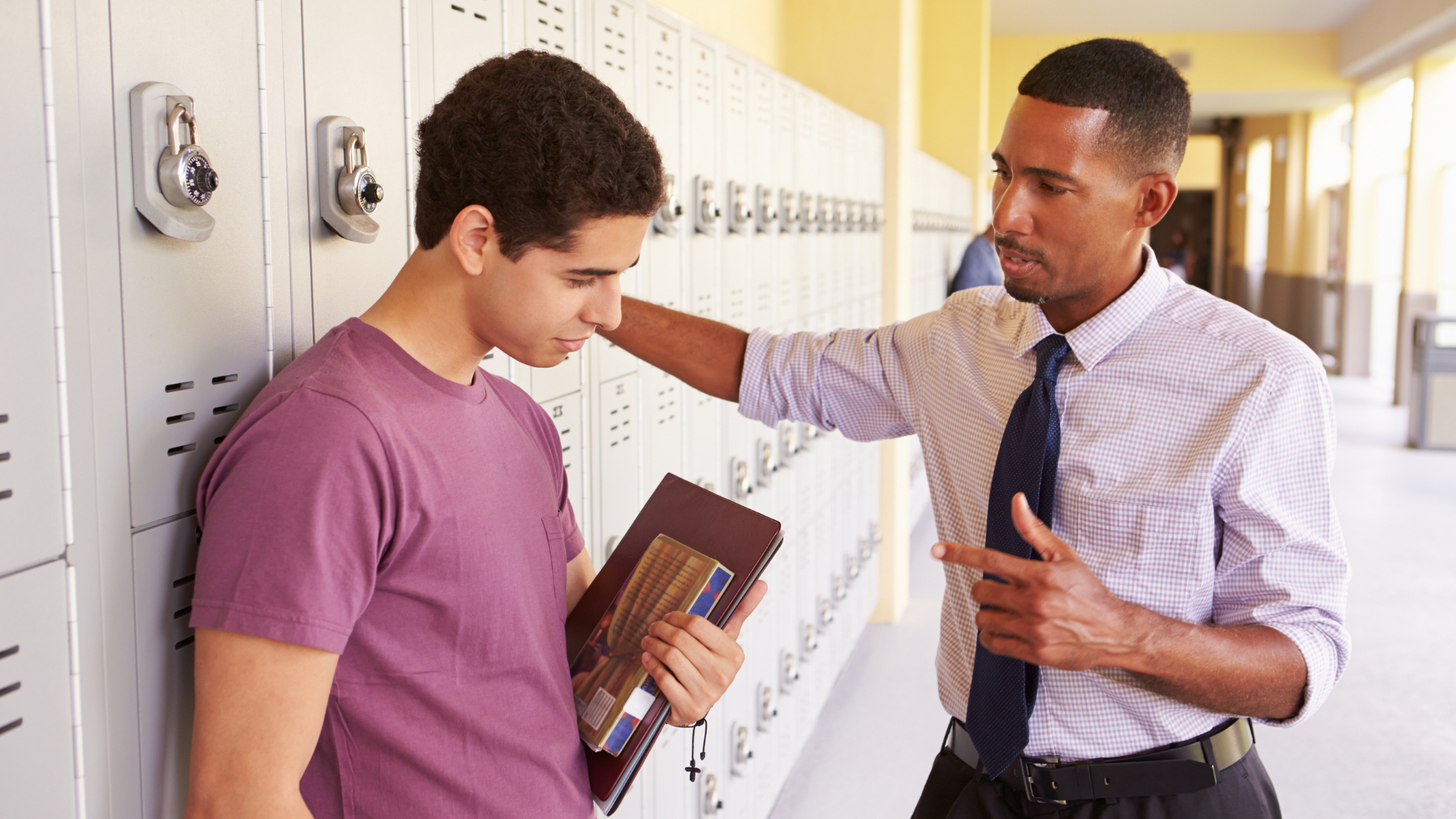Teacher Resistance to PBIS: Psychological Barriers and Erroneous Beliefs
Here are eight reasons and beliefs on why a teacher may resist using PBIS for student discipline — and how you can help overcome that resistance.
Implementing positive behavioral interventions and supports (PBIS) in schools can be a daunting and challenging proposition. Successful implementation demands awareness training, staff-needs assessment, comprehensive data review, staff-skill training, and extensive PBIS design work.
However, often overlooked is the need to assess and address the common staff concerns for implementing PBIS.
These common concerns represent misunderstandings, erroneous beliefs, and perceived barriers about the underlying conceptual and practical aspects of PBIS.
Additionally, it’s important to understand the general psychological barriers to change that are typically present.
It’s essential in the planning stages to know what erroneous beliefs to expect from staff and their underlying psychological mechanisms. These common misconceptions can be successfully addressed through staff engagement, professional development, and implementation support.
In this blog, we will outline the most common psychological barriers, erroneous beliefs, and perceived impediments to successful PBIS implementation as described by Tyre and Feuerborn (2021).

Why Should I Implement PBIS in My School?
PBIS is a framework designed to be implemented in a consistent manner for all staff, students, and settings across the entire school. From a multi-tiered perspective, PBIS is highly preventative and applies to all students, helping create a foundation for a positive, healthy school climate.
PBIS involves the teaching of:
- Prosocial behaviors
- Clearly defined expectations
- Consistent reinforcement for positive behavior
- Corrective responses for problem behaviors
Some students can receive more targeted and personalized behavior reinforcements and corrective responses based on their needs (Sugai & Horner, 2006).
Based on over two decades of research, the positive impacts on students and schools are unequivocal:
- Improved student academic outcomes and perceptions of school climate
- Improved staff morale and perceptions of school climate
- Reductions in behavioral referrals leading to exclusionary discipline (e.g., Bradshaw et al., 2008, 2009; Ross et al., 2012)
As is the case with the implementation of any new initiative in schools, establishing staff “buy in” and addressing resistance are essential because significant resistance can thwart a successful implementation.
This is not to say that all staff must fully agree, but it’s important to address the most glaring sources of resistance. The reasons for resistance are complex and related to individual, systemic, or PBIS-related factors.

Resistance to Change is Normal
The fact is human beings are thought to be hardwired to resist change.
In the brain, the amygdala views changes in the environment as threatening, which causes a release of specific hormones to invoke a fear, fight, or flight response.
The bottom line is that teachers who resist implementation and delivery of PBIS can engender poor morale among colleagues, create lack of cohesion among staff, and demonstrate general weak fidelity of implementation — which will ultimately negatively impact positive outcomes for students (Hall & Hord, 2011).
In addition to this biological resistance, there are numerous reasons why teachers may be resistant to PBIS.
Kanter (2012) posits there are several psychological reasons people resist change in the corporate world but that these reasons can be directly applied to the educational environment and the typical educational initiative.
By understanding these psychological reasons, educational leaders can proactively mitigate these factors.
Common Reasons for Educator Resistance to the Implementation of PBIS
1. Loss of Control
This relates to autonomy and agency. A resistant teacher may express an exaggerated need to maintain “professional autonomy and independence (Hargreaves and Dawe 1990, Jay 2009, Bean et al. 2010).
Thus, resistance to change for some can be understood as an expression of teachers’ professional and intellectual freedom as well as personal agency (Musanti and Pence 2010, Sannino 2010, Riveros et al. 2012).
Additionally, a teacher may have deeply held beliefs or professional commitments that are at odds with the proposed behavioral program changes — what is referred to as principled resistance (Achinstein and Ogawa 2006).
Self-determination is threatened when faced with a potential change coming from an outside source.
2. Excess Uncertainty
Change can sometimes feel like jumping off a diving board with a blindfold. As the saying goes, “Better the devil you know than the devil you don’t know.” It is essentially fear of the unknown, and some people can cognitively create scenarios that exacerbate the natural fear engendered by uncertainty.
This fear may make resistant teachers say and do things they would not normally say and do. It shows up as opposition, confrontation, or unwillingness.

3. More Work
This cause for resistance is very much universal, and the unavoidable fact is that the change in a school brought on by implementing PBIS could involve more work if not managed correctly.
Those responsible for designing a new PBIS program and implementing it are often overloaded, and this certainly adds new things to teachers’ workflow.
A recent study found that 90% of teachers are feeling burned out and thus leaders must be sensitive and cognizant that their teachers simply may not have the personal “battery power” to implement PBIS effectively at the present time.
One common phenomenon observed in districts is what’s called initiative fatigue, where educators are faced with new transformative initiatives on a regular basis and so they simply don’t have the energy to engage in “one more thing.”
4. Surprise
Often you will hear people in organizations respond to information about coming changes by saying, “Why didn’t we know about this earlier?” or something similar.
The decision to implement a PBIS program and then suddenly communicating this to teachers — with no time to prepare or process the change — for the consequences will engender resistance for some.
5. Everything is Different
Teachers are highly variable in their attitudes toward growth and change.
According to Zimmerman (2006), resistant teachers are especially reluctant to change when they:
- Do not believe a change is needed
- Are reluctant to change their routines
- View past change as unsuccessful
- Perceive change as a threat to relationships with colleagues and school leadership (e.g., principals)
- Feel their expertise would be undermined by change
When we implement a behavioral program, some things are inevitably going to change, and change is meant to bring on something different — but how different?
We are creatures of habit. Routines become automatic. But change that is too dramatic creates great unease.
Too many differences can be confusing, and people will wonder how all the changes will impact their lives.

6. Ripple Effects
When implementing any initiative in education, it’s critical to understand the linkages with other ongoing initiatives.
Teachers often ask how this initiative dovetails with other initiatives, and a resistant teacher may view PBIS as interfering with other important work.
This is when teachers start to push back, rebelling against changes they had nothing to do with that interfere with their own preferred activities.
Similar to throwing a pebble into a pond, change creates ripples that move across the institutional pond in ever-widening circles. These ripples can disrupt much other work in unintended ways.
7. Philosophical Mismatch
Each teacher enters the classroom with a unique conception of how students learn and exhibit positive behaviors.
Many teachers receive little behavioral management training in their pre-service, so they simply may not understand the science of behavior change and management.
In these cases, teachers rely on their intuition and may fall into a strictly punitive approach to discipline. Others have simply learned on the job and adopted a particular philosophy from their peers and colleagues.
8. Concern About Competence
Some teachers may feel they lack the competence to implement the PBIS framework with fidelity and are afraid to admit they lack the knowledge and skills in classroom behavior management.
Additionally, admitting that PBIS methods are needed may highlight current failures in classroom management.

Common Erroneous Beliefs
Belief 1: “We are already doing [specific program]. Isn’t that enough to address the problem?”
A staff member who makes a statement like this likely does not accurately understand the nature of PBIS and may think it is a “program that comes in a box,” like some curriculum resource.
How to Address This Belief
Explain to them that PBIS is a flexible framework inherent in many different programs and systems implemented in schools, at least to some extent.
They may feel what they are currently doing is sufficient and may interfere with other initiatives. This misconception reflects the “ripple effect” noted above.
Belief 2: “We can’t take on another program or initiative.”
Although potentially an erroneous belief, in some instances this might be a very accurate perception. Sometimes, districts institute initiatives in a haphazard fashion, which can cause staff to suffer from initiative fatigue.
A recent study found that 90% of teachers are feeling burned out; thus we must be sensitive and cognizant that they simply may not have the personal “battery power” to be on board with implementing PBIS effectively at this time.
How to Address This Belief
This belief is an example of the “more work” barrier noted above, and it is critical to map out how all existing programs and initiatives interact and support each other in a coherent manner — and then clearly articulate this to staff.
Belief 3: “We need to give consequences to students for their misbehavior, and rewards are not needed.”
This erroneous belief may stem from a philosophical belief that consequences or corrective responses alone are the best way to curb negative student behavior. It’s an example of “philosophical mismatch” noted above.
When introducing PBIS, it’s important for trainers not to create the perception that PBIS is the polar opposite of providing consequences or corrective responses.
It is common for people to misunderstand that PBIS involves only positive reinforcement while negative behaviors are completely ignored.
How to Address This Belief
The major point to make to staff with this erroneous belief is that there is a shift in the broad focus to the behavior-changing effects of defining, teaching, and acknowledging students for meeting behavioral expectations — which will reduce the general need for corrective responses.

Belief 4: “I don’t believe most teachers will accept and implement PBIS, so why should I?”
Some staff may be skeptical because they feel that even though they support PBIS implementation, they may believe their colleagues will not. They may believe they should not put forth the effort because their efforts will be in vain if others are not willing to do the same.
Also, if adopters are greatly outnumbered by the resistors, this can create animosity and rebuke from colleagues.
Classroom teachers spend almost all of their time in their classroom, so they have little information as to fidelity of PBIS implementation in other classrooms. They may believe others are not changing their practices, which can influence their own decision to adopt or reject PBIS.
How to Address This Belief
- Share data that demonstrates the fidelity of implementing PBIS
- Share PBIS success stories
- Provide demonstrations of PBIS implementation in staff meetings
- Provide opportunities for staff to collaborate in their implementation efforts (e.g., in professional learning communities)
Belief 5: “I don’t think we should bribe students with reinforcements for expected behaviors.”
This may be the most common erroneous belief and the most difficult to overcome for PBIS trainers and behavioral consultants.
The underlying erroneous belief is that external reinforcement and rewards do more harm than good for students. The best example of this is the misconception that rewards or reinforcements could subvert students’ intrinsic motivation and have long-term negative impacts on students.
As students develop, they generally are less motivated by adult verbal praise and become more motivated by tangible things — such as privileges, material goods, or good grades — which makes some teachers feel that positive reinforcements used in many PBIS implementations will exacerbate this phenomena.
How to Address This Belief
Acknowledge that there are appropriate and inappropriate ways of using positive reinforcement.
For example, when beginning to use PBIS approaches, it is acceptable to reinforce expected basic behaviors (e.g., raising hand to speak) until they are well-established. Then begin to “fade” those behaviors from frequent reinforcement to a less frequent interval, and then begin to only reinforce more advanced behaviors aligned with schoolwide expectations.

In this regard, staff training should outline the situations and conditions to use reinforcements in a thoughtful, judicious manner.
For example, it is not a best practice to provide frequent reinforcement for simple behaviors that do not require some thought or effort on the part of the student.
Also, here are some points worth considering:
- Reinforcement on a random basis is more powerful than reinforcement given out on a highly frequent basis.
- Additionally, it’s important to pair social reinforcement (e.g., praise) with tangible reinforcement.
- Another major intention behind the use of reinforcements is to reduce the use of negative interactions between students and adults.
- The concept of extinction (planned ignoring of low-level negative behaviors) paired with reinforcing incompatible positive behaviors serves to create a more positive classroom climate and engender a more cooperative attitude in students.
Belief 6: “We need to get tougher on these students and make them do what they are told.”
This is another common erroneous belief: that the only way to reduce behavior problems is to get really tough and punitive.
However, schools with tough discipline systems, including zero tolerance approaches, tend to have negative outcomes (American Psychological Association Zero Tolerance Task Force, 2008).
Often these systems use exclusionary methods (and typically in an inequitable or disproportionate manner for students of color or students with disabilities). These students are less likely to graduate and more likely to become involved in the juvenile justice system.
In the long run, suspending students from the classroom may exacerbate the problem by creating more distance and disconnection from school.

How to Address This Belief
To address this belief, share the research around the negative impacts of punitive approaches and the positive outcomes of positive approaches.
Belief 7: “Students who cause trouble in my classroom should be placed in another special setting, classroom, or school.”
This erroneous belief stems from the notion that, as a regular classroom teacher, they lack the competence to meet the needs of students with challenging behavior, who are best supported in a special classroom for students with behavioral challenges (Tyre et al., 2019).
How to Address This Belief
Explain that one of the basic tenets of PBIS is that ALL students will be helped and supported using the PBIS framework, and individual plans within the broader framework will meet the needs of the few more challenging students.
Undoubtedly, severely disruptive, disrespectful, or aggressive students can cause great stress on a teacher, so teachers may require a variety of support beyond the usual PBIS methods, such as paraprofessional support, school psychological services, and broader family interventions.
Belief 8: “Doing PBIS and delivering rewards, points, and tokens takes too much time and effort and makes it all very frustrating.”
Implementing PBIS frameworks can be a challenging endeavor, and we have highlighted the psychological and erroneous belief system barriers that exist in the field.
Another challenge of implementing PBIS frameworks involves the mechanical and physical processes involved in delivering positive reinforcement that adds additional work to the teachers’ plate.
Clearly, this adds a completely new set of behavioral motions on the part of the teacher, and the belief of extra work can be quite accurate.
How to Address This Belief
To help alleviate this potential barrier to implementation, implement a well-designed software system that automates many of these motions and also serves to increase student engagement and motivation.
SchoolMint Hero is one such platform.
SchoolMint Hero is aligned to the best practices of positive behavior support systems (PBSS) and PBIS to provide consistency and fidelity of implementation, which can lead to an improved student behavior, reduced student behavior problems.
SchoolMint Hero delivers the PBIS framework and best practices insofar as instituting consistent responses to behavior, positively reinforcing good behavior, providing corrective responses, and tracking students in behavioral interventions.
Simply put, SchoolMint Hero makes it easy for the teacher and, in the long run, helps reduce their stress and workload since they will spend less time dealing with student behavioral incidents.
In conclusion, we must understand and address both the underlying psychological factors seen in resistance as well as the multitude of misunderstandings and erroneous belief systems in our educational staff with regards to PBIS implementation.
It is essential to deliver quality professional development with these factors in mind and provide teachers with quality software tools to improve fidelity and reduce teacher workload.
If you’d like to learn how SchoolMint Hero can support PBIS in your school, get in touch here.
Share this
You May Also Like
These Related Stories

Understanding Restorative Justice in Schools and How SchoolMint Hero Can Help

Best Practices for Tardy Management in Schools


